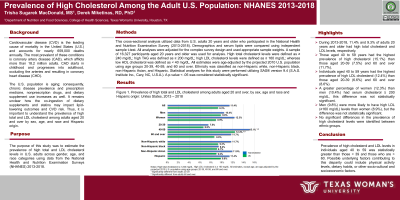Back

Objectives: The purpose of this study was to estimate the prevalence of high cholesterol in U.S. adults across gender, age, and race categories using data from the National Health and Nutrition Examination Surveys (NHANES) 2013-2018.
Methods: A sample of 16,327 participants aged 20 years and older were used for analysis. High total cholesterol levels were defined as ≥ 240 mg/dL; high TAG was defined as ≥ 200 mg/dL; high LDL cholesterol levels were defined as ≥ 160 mg/dL; whereas low HDL cholesterol was defined as < 40 mg/dL. All estimates were age-adjusted by the projected 2010 U.S. population using age groups 20-39, 40-59, and 60 and over. Ethnicity was classified as non-Hispanic white, non-Hispanic black, non-Hispanic Asian, and Hispanic. Statistical analyses for this study were performed utilizing SAS® version 9.4 (S.A.S. Institute Inc., Cary, NC, U.S.A.). A p-value < 0.05 was considered statistically significant.
Results: During 2013-2018, 11.3% of adults 20 years and older had high total cholesterol. Those aged 40 to 59 years had the highest prevalence of high cholesterol (15.1%) than those aged 20-39 (7.5%) and 60 and over (11.7%). Although a greater percentage of women (12.0%) than men (10.4%) had serum cholesterol ≥ 200 mg/dL, this difference was not statistically significant. Further, there were no significant differences in the prevalence of high cholesterol between ethnic groups.
Conclusions: Prevalence of high cholesterol levels in individuals aged 40 to 59 was statistically greater than those < 39 and those who are > 60. Possible underlying factors contributing to this disparity could include physical activity levels, dietary habits, or other socio-cultural and socioeconomic factors.
Funding Sources: None to declare.
Nutritional Epidemiology
(PO22-36-22) Prevalence of High Cholesterol Among the Adult U.S. Population: NHANES 2013-2018


Trisha S. MacDonald, MS
– PhD Student, Texas Woman's University, Sugar Land, Texas, United States
Presenting Author(s)
Disclosure(s):
Trisha S. MacDonald, MS: No relevant financial relationship(s) with ineligible companies to disclose.
Objectives: The purpose of this study was to estimate the prevalence of high cholesterol in U.S. adults across gender, age, and race categories using data from the National Health and Nutrition Examination Surveys (NHANES) 2013-2018.
Methods: A sample of 16,327 participants aged 20 years and older were used for analysis. High total cholesterol levels were defined as ≥ 240 mg/dL; high TAG was defined as ≥ 200 mg/dL; high LDL cholesterol levels were defined as ≥ 160 mg/dL; whereas low HDL cholesterol was defined as < 40 mg/dL. All estimates were age-adjusted by the projected 2010 U.S. population using age groups 20-39, 40-59, and 60 and over. Ethnicity was classified as non-Hispanic white, non-Hispanic black, non-Hispanic Asian, and Hispanic. Statistical analyses for this study were performed utilizing SAS® version 9.4 (S.A.S. Institute Inc., Cary, NC, U.S.A.). A p-value < 0.05 was considered statistically significant.
Results: During 2013-2018, 11.3% of adults 20 years and older had high total cholesterol. Those aged 40 to 59 years had the highest prevalence of high cholesterol (15.1%) than those aged 20-39 (7.5%) and 60 and over (11.7%). Although a greater percentage of women (12.0%) than men (10.4%) had serum cholesterol ≥ 200 mg/dL, this difference was not statistically significant. Further, there were no significant differences in the prevalence of high cholesterol between ethnic groups.
Conclusions: Prevalence of high cholesterol levels in individuals aged 40 to 59 was statistically greater than those < 39 and those who are > 60. Possible underlying factors contributing to this disparity could include physical activity levels, dietary habits, or other socio-cultural and socioeconomic factors.
Funding Sources: None to declare.

.png)
